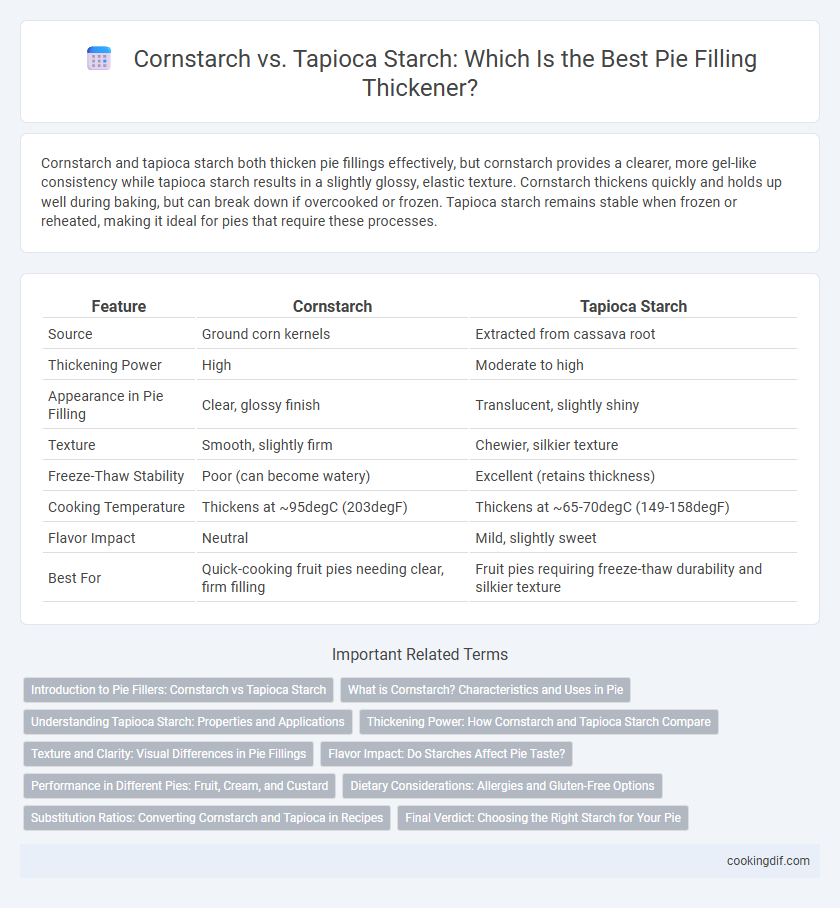Cornstarch and tapioca starch both thicken pie fillings effectively, but cornstarch provides a clearer, more gel-like consistency while tapioca starch results in a slightly glossy, elastic texture. Cornstarch thickens quickly and holds up well during baking, but can break down if overcooked or frozen. Tapioca starch remains stable when frozen or reheated, making it ideal for pies that require these processes.
Table of Comparison
| Feature | Cornstarch | Tapioca Starch |
|---|---|---|
| Source | Ground corn kernels | Extracted from cassava root |
| Thickening Power | High | Moderate to high |
| Appearance in Pie Filling | Clear, glossy finish | Translucent, slightly shiny |
| Texture | Smooth, slightly firm | Chewier, silkier texture |
| Freeze-Thaw Stability | Poor (can become watery) | Excellent (retains thickness) |
| Cooking Temperature | Thickens at ~95degC (203degF) | Thickens at ~65-70degC (149-158degF) |
| Flavor Impact | Neutral | Mild, slightly sweet |
| Best For | Quick-cooking fruit pies needing clear, firm filling | Fruit pies requiring freeze-thaw durability and silkier texture |
Introduction to Pie Fillers: Cornstarch vs Tapioca Starch
Cornstarch and tapioca starch are two popular thickeners used in pie fillings to achieve the desired consistency and texture. Cornstarch, derived from corn kernels, provides a smooth and glossy finish while thickening quickly at moderate temperatures. Tapioca starch, extracted from cassava root, offers a clearer appearance and a chewier texture, making it ideal for fruit pies that require longer baking times without becoming overly gelled.
What is Cornstarch? Characteristics and Uses in Pie
Cornstarch, a fine white powder derived from corn kernels, is a popular thickening agent in pie fillings due to its ability to create a smooth, glossy texture and clear finish when cooked. It gelatinizes quickly at around 203degF (95degC), providing a thick, stable consistency without altering the flavor of fruit fillings. In pies, cornstarch is favored for its ability to hold up well under baking heat, ensuring the filling maintains its shape and prevents weeping.
Understanding Tapioca Starch: Properties and Applications
Tapioca starch, derived from the cassava root, offers excellent clarity and elasticity when used as a pie filling thickener, making it ideal for fruit-based pies requiring a glossy, transparent finish. Its superior freeze-thaw stability prevents separation and syneresis, ensuring the pie filling maintains a smooth texture even after refrigeration or freezing. Compared to cornstarch, tapioca starch forms a more stable gel at lower temperatures, enhancing its application in fillings that need a tender, juicy consistency without cloudiness.
Thickening Power: How Cornstarch and Tapioca Starch Compare
Cornstarch has a higher thickening power than tapioca starch, making it ideal for pie fillings that require a firmer texture. Tapioca starch provides a more flexible and glossy consistency, which helps prevent filling from becoming too dense or gummy. Understanding the differences in thickening strength ensures the perfect pie filling texture tailored to specific recipes.
Texture and Clarity: Visual Differences in Pie Fillings
Cornstarch creates a thick, glossy filling with a smooth, gel-like texture, enhancing the pie's visual appeal through its clear, vibrant finish. Tapioca starch produces a more translucent, slightly chewy filling that remains stable when frozen, offering a less glossy but appealingly transparent appearance. Choosing between cornstarch and tapioca starch affects the pie filling's texture and clarity, influencing the overall presentation and mouthfeel of the dessert.
Flavor Impact: Do Starches Affect Pie Taste?
Cornstarch provides a neutral flavor that allows the natural fruit taste in pie fillings to shine without interference, making it ideal for delicate or subtle-flavored pies. Tapioca starch has a slightly sweet, earthy undertone that can subtly enhance the overall flavor profile, particularly in richer or tropical fruit pies. Both thickeners deliver a glossy finish, but cornstarch yields a smoother texture, whereas tapioca imparts a slightly chewier bite that some bakers prefer.
Performance in Different Pies: Fruit, Cream, and Custard
Cornstarch provides a strong, opaque thickening ideal for fruit pies, creating a glossy, firm filling that holds shape well during baking. Tapioca starch excels in cream pies and custards with a translucent, chewy texture that remains stable when frozen or reheated, preventing syneresis. Each starch interacts differently with pie fillings: cornstarch delivers a sturdier consistency for acidic fruits, while tapioca starch offers smoothness and elasticity crucial for delicate custards and cream-based desserts.
Dietary Considerations: Allergies and Gluten-Free Options
Cornstarch, derived from corn, is a gluten-free thickener commonly used in pie fillings but may trigger allergies in individuals sensitive to corn. Tapioca starch, extracted from the cassava root, is also gluten-free and hypoallergenic, making it a safer alternative for those with corn allergies or gluten intolerance. Both starches provide effective thickening while supporting dietary restrictions related to gluten and allergen avoidance.
Substitution Ratios: Converting Cornstarch and Tapioca in Recipes
When substituting cornstarch for tapioca starch in pie filling, use a 1:1 ratio as both thickeners have similar thickening strength. Tapioca starch provides a clearer, glossier finish, while cornstarch can produce a more opaque appearance. Adjust slightly for texture preferences, especially in fruit pies, where tapioca's elasticity enhances the filling's chewiness.
Final Verdict: Choosing the Right Starch for Your Pie
Cornstarch provides a glossy, translucent finish and thickens quickly, making it ideal for fruit pies that require a firm yet tender filling. Tapioca starch yields a clearer, slightly more elastic texture and remains stable when frozen, perfect for pies with juicy or tropical fillings. Selecting between cornstarch and tapioca starch depends on the desired consistency, appearance, and storage needs of your pie filling.
Cornstarch vs tapioca starch for pie filling thickener Infographic

 cookingdif.com
cookingdif.com